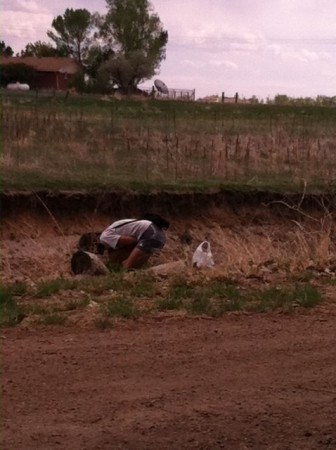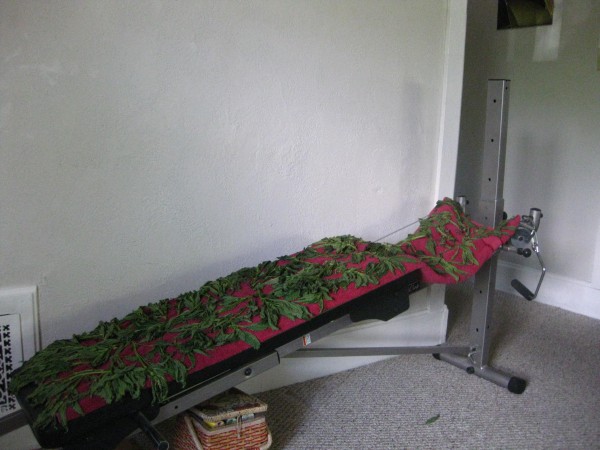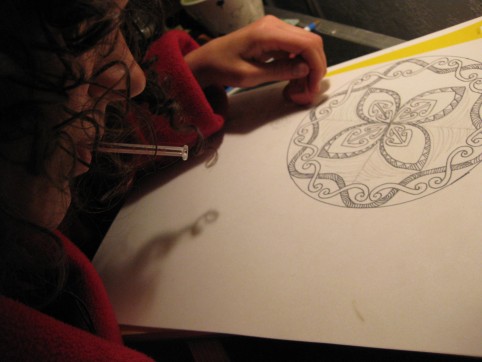
Hello to all of you, and happy 2014! March already! And definitely time to get back to blogging — I’ve missed it — but first a health update, which is the main reason I’ve been away from my little blog for so long.
It’s been a bad phase these past several months. I’ll go into some detail because in the past I’ve appreciated reading about other peoples’ health experiences, so who knows — maybe this’ll be useful to someone out there.
***
Over the summer I worked very hard on my health, putting much belief and many, many hours into a radionics machine developed in Germany that’s supposed to heal the body by transmitting specific wavelengths into it through a brass handplate and a mat that you sit against, thereby eliminating bacteria, viruses, parasites, etc. The health claims out there about bioresonance and radionics machines can be pretty fantastic, while the criticism is equally harsh. The person I was working with uses the machine differently than the way it was developed to be used, but the implication was that “this’ll cure what ails ya.”
Unfortunately it didn’t. And neither did the chiropractic care (better alignment really felt good though!) or months of acupuncture (though I really liked acupuncture and definitely felt its effects) or Xiao Chai Hu Tang Chinese herbal pills.
This past September, I was feeling like I truly needed to go back to a conventional Western doctor, distasteful as that thought was. In fact I’d rather clean toilets all day. And the idea of embarking on another diagnostic odyssey to find out What Else is wrong was overwhelming. Just figuring out the Brucellosis piece involved so many months of torturous doctor visits, tests, and bloodshed (144 vials of blood, and counting, drawn over the past 3 years that I’ve felt like crap) that I just wanted to turn away from it all…shut the door…and never have to face any of it ever, EVER again.
But what I hate even more than going to the doctor, is being sick.
So.
***
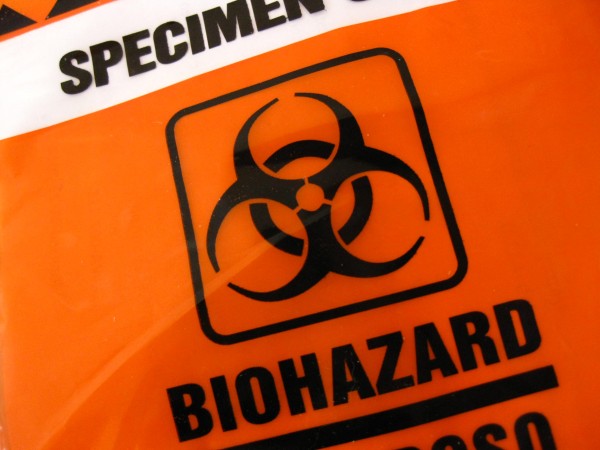
After finishing 10 months of antibiotics in Sept. 2012 for the Brucellosis, I was 80-90% better — SO much better than I had been — but not 100%. The Colorado health department nurse had told me that even after finishing the treatment, I may still get some fevers, joint pain, fatigue, etc. for a while. And so I kept waiting for my body to come back up fully, but it never quite did.
The fatigue was still there and getting worse, and then the cough and chest heaviness and fevers returned, though not some of the other familiar brucellosis symptoms. So this September (2013) when I went back to the doctor, I said it felt like the chest infection that I got 3 years ago in Argentina in 2010 was still there, but that we should also do a repeat Brucella antibody test to see where we’re at with that, since I had the chest symptoms during the Brucellosis (and thought they might have been one in the same).
So we did a chest x-ray (read as normal), bloodwork (high neutrophils, a type of white blood cell), and repeat Brucella antibody test — which was finally negative!! After 4 positives over the past 2 years, seeing that negative result was an incredible relief because Brucellosis is a difficult bacteria to get rid of. It meant that the doxycycline and rifampin had done their job, but it also meant that I had another infection going on, which wasn’t gone yet.
A few days after the first visit back to the doctor, my lungs were having so much trouble that I called the clinic and they had me come in. But driving there, I started feeling very awful, like I was going to pass out behind the wheel and needed to either get there fast, or get out of traffic and pull over. I nearly rear-ended someone trying to get out of traffic, and by the time I pulled into the clinic parking lot, I was having a lot of trouble breathing, my hands were paralyzed and I couldn’t move my fingers, and my abdominal muscles and diaphragm were clenching up like a tight fist. It was the scariest thing I hope I ever have to experience. I flew through the front doors, cut everyone in line, and flopped onto the front desk and said “I NEED HELP.” Nurse STAT to the front desk was called over the intercom, and I was wheeled back to the urgent care area. It was dramatic and embarrassing.
They started an IV and did some quick bloodwork which showed that my potassium was critically low, which explained the muscle paralysis. Potassium is an extremely important electrolyte, because our vital functions (breathing and pumping blood) depend on muscle, and muscles must have adequate potassium. They gave me a double potassium cocktail to drink. My heart rate was very fast and the EKG showed some ‘ischemia’ (insufficient bloodflow) and I was still feeling really weird and my breathing wasn’t right, so the doctor decided to transfer me to the emergency room by ambulance. After 6 hours of monitoring there, and an IV of magnesium (helps with potassium absorption), I was stable enough and feeling strong enough to walk around and go home.
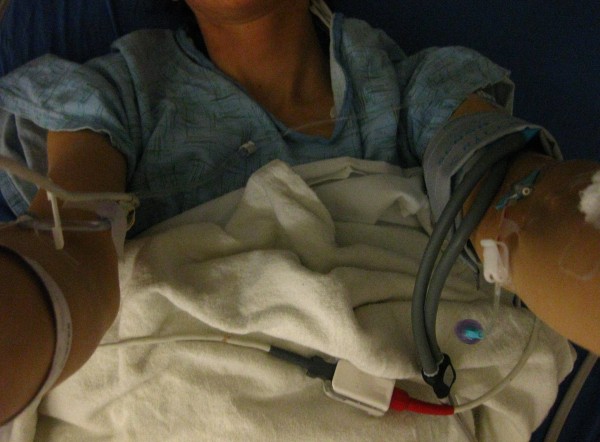
In the ER
They put me on supplemental potassium which has helped my body feel much more stable, but over the next weeks I was still having the difficult breathing and chest heaviness and the sense of a smoldering lung infection — the same as what I’d been experiencing for most of 2013 (and also much of 2011 before the anti-brucella antibiotics took care of the issue almost completely). And then one night in mid-October, after a big day of yard work, my usual low-grade fever went up to 102.5 and my body and joints and lymph nodes began to hurt at a level of intensity I’ve never felt before — far worse than with any flu I’ve ever had. The next night I passed out when I got up to go to the bathroom, and my lungs hurt too. Two days later I went back to the doctor. She ordered another chest x-ray and bloodwork; my white count was still high, this time with high band-neutrophils too, and the x-ray showed pneumonia. It was in a tricky part of my left lung (the lingula) which is harder to see on x-ray because our heart is in the way. The doctor said the pneumonia had probably been cooking for a while but was not pronounced enough to be seen on the x-ray taken 3 weeks prior — especially since my bloodwork from 3 weeks prior was showing a high white count.
She said “I’m pullin’ out the big gun” and gave me Levaquin and said my fever should be going down within 24 hours. 24 hours later, my fever had gone up over 103, but by day 3 or 4 it was finally down. Those were miserable days.
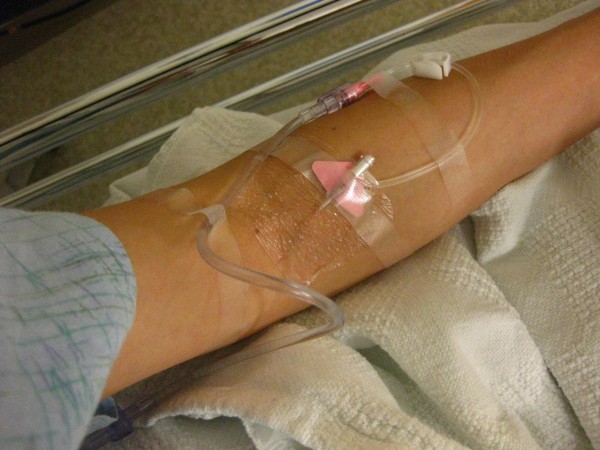
I’ve had six of these in the past five months…
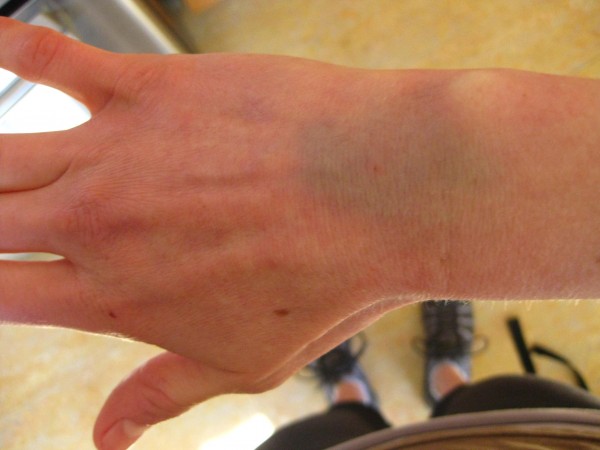
…not counting the multiple failed IV attempts, leaving me looking rather battered with ouchy bruises that last for weeks!
And the maddening, exhausting journey continues. More doctor visits regarding both wacky lungs and wacky electrolytes, trying to figure out if they’re related and how. Another chest x-ray a month later showed that the pneumonia infiltrate was still there, so I had another round of a combination of antibiotics. My long-awaited referral to see a pulmonologist turned out to be a complete waste of money, and I was hitting dead ends left and right. Doctors often hold the keys to finding out what’s wrong with you because of the world of tests and procedures they have access to. But when they won’t listen and don’t feel like digging in to help figure out what’s wrong, and they only have 15 minutes before they have to move onto the next patient, then they become the obstacle. Your health suffers because of the doctor. This became the situation.
One thing that went very right during all of this was our new Obamacare took effect. All I can say is, THANK YOU OBAMA!!!!!!!!!!!!!!!!!!!!!!!!! THANK YOU THANK YOU THANK YOU!!!!!!!!!!!
Because of Obamacare, I was able to take the opportunity to say good bye (and very good riddance) to Kaiser. When I began Kaiser 7 years ago, I was determined to make up my own mind about them and not be swayed by others’ opinions. Well, 7 years later, I can say that I’ve gotten some good care from them, and also some very negligent care. Looking back, I am angry at what I see. Very angry, actually. You couldn’t pay me to go back to Kaiser. Thank goodness F. encouraged me to explore other options and look elsewhere for insurance, and thanks to him, I got myself into a much better insurance situation at a much better hospital and I’m getting far better care at a much faster pace. At this new hospital, I’ve had more testing and procedures and specialist visits in the past 6 weeks than Kaiser ever would have coughed up. I’m sure Kaiser is good for the simpler things that can go wrong, but if you have something complex and unusual going on, get thee the heck out of the ‘local Kaiser family medicine’ sphere, and up to the regionally or nationally recognized, University-type or similar, health care level. Somewhere that actually has a reputation, where they have smart doctors who will spend an hour or two with you on multiple occasions to really dig in and do some testing and partner with you to figure out what’s wrong.
I am blessed and feeling infinitely grateful to be receiving care at this level. There is a huge difference. I’m seeing that now.
Anyway, as part of the wacky-electrolyte investigations, an incredibly painful blood test called Arterial Blood Gases was done, where they dig around with a needle deep inside your wrist to find the artery, and then draw blood from it. Jeezus it was painful. From this test they could tell that my blood pH was too high — a respiratory alkalosis. Our blood pH is very tightly regulated to stay right around 7.40, and when it sways too far toward either acid or base, major things can go wrong with body chemistry, with major implications. One theory is that my lung issue and chest heaviness and difficult breathing causes me to breathe differently which causes my CO2 to fall too low, thereby raising my blood pH and throwing off other elements of my body chemistry like potassium and some other stuff. The results of a couple other tests indicate that there may be another electrolyte issue going on that adds to the effect of this, and that’s something we’re still investigating.
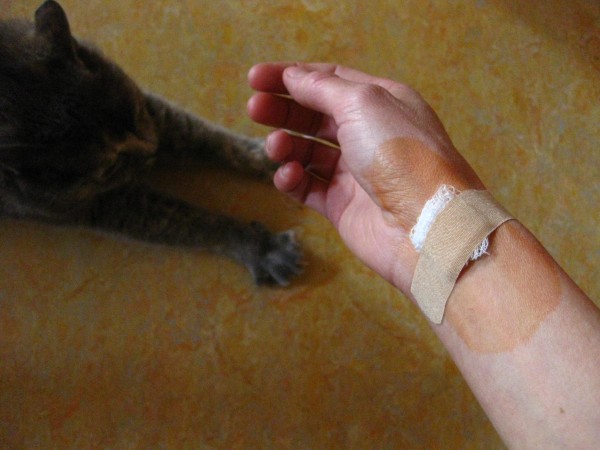
After getting arterial blood gases drawn. A nerve got nicked in the process, causing excruciating pain for a while. It’s all better now though. I also had a Home CAT Scan done, which you can see in the background. That scan determined that everything would be A-OK, giving me great peace of mind.
And so where does it all stand now?
This new hospital is doing some very good, thorough investigating which has enabled us to begin ruling stuff out, and also to pick up important clues.
A repeat chest x-ray showed thickened airways, but that the pneumonia infiltrate is gone. However I’m still feeling symptoms of an ongoing smoldering lung infection, and my neutrophils and bands are still high, with lymphocytes low. A chest CT scan showed bronchiectasis (permanent lung damage), a few nodules, and a calcified granuloma (from brucellosis maybe? Or from what’s going on now, maybe?). Other tests are pending, and I have been submitting some sputum samples for culture. My ANA has come back twice as being mildly positive at 1:160, which is new since it’s always been negative in the past. But since all other autoimmune tests have come back negative, it could be from infection, or nothing at all.
Because of the bronchiectasis, they gave me an ingenious little device called an Aerobika. It’s a simple mechanical thing, no medication involved, which you exhale into repeatedly for about an hour a day total. It has really helped to loosen some of the gunk in my lungs, making it easier to breathe and relieving some of the chest heaviness. And when I’m breathing better, I’m sleeping better. And that is a HUGE thing.
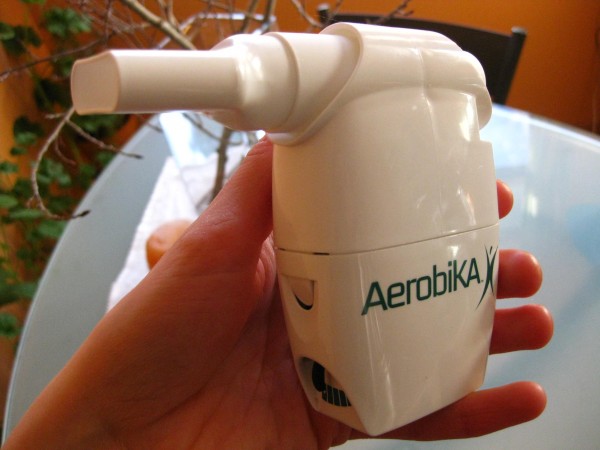
It’s my Respiratory Toy!
Last week I called the doctor though, because the tricks I’ve discovered to keep my lungs light enough to get some sleep (the Aerobika partnered with coughing as hard as I can, as often as I can throughout the day) weren’t cutting it and I was wondering about a saline nebulizer attachment for the Aerobika that the respiratory therapist had told me about. But the doctor said before we do that, I should drop off another sputum sample and come in for an appointment. And although none of the sputum cultures are finalized yet (that takes 6 weeks), it turns out that so far they’re growing E. coli, which is not a bacteria that belongs in your lungs.
So we’re going to do a sorta-urgent bronchoscopy, scheduled for the day after tomorrow, to go into my lungs with a fiberoptic scope and get more of an idea of what’s cooking in there. They’ll go into the damaged area and do a lavage (a “wash” — meaning they inject saline and suck it back out, and send it to the lab for culture and analysis), as well as snip out some biopsy samples for the lab to look at, and if they see mucus they’ll suck some of that out and culture it.
And right after the bronchoscopy is done, I can begin antibiotics. Sensitivity testing showed that luckily this particular E. coli bugger is susceptible to the antibiotic TMP-SMZ. At this point it’s unclear whether E. coli is the main culprit for the lung damage that’s been done, or if it’s only part of the problem. The bronchoscopy may shed more light.
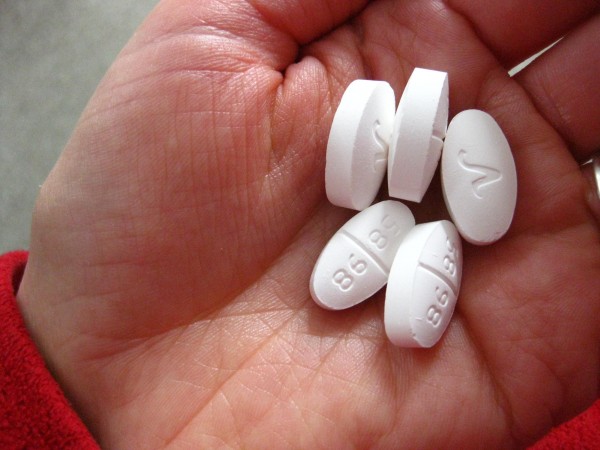
They’re huge!
***
My body doesn’t give up its secrets easily. I am otherwise very healthy… I always have been and there was never any major health drama growing up. I eat very nutritiously and do so many of the right things for my body. And so my body is strong and resilient. I have youth on my side too, but my body amazes me with its strength. But one downside to that, I believe, is that it’s able to keep things like infections tamped down lower than maybe someone with poorer health (yes that can be a downside!). Something’s wrong and the clues are there, but they’re just more subtle, and looking at me you would never guess my body has felt like it’s been sick with a never-ending flu for the past 1,500 days. When you’re trying to get the medical care you need, looking the picture of health isn’t necessarily helpful! What I hope is that we will be able to identify and get rid of all the bacterial crud that’s dragging my body down and preventing it from regaining its full, radiant health that I know it’s capable of.
And what an eye-opening education this all has been these past several years. As a by-product, I’m getting a full tour of the best and worst of both Western and Alternative medicine. And I have changed my opinions about them both. I used to think I didn’t believe in Western medicine. It certainly has its problems, but before I got sick, it was easy to sit perched in my healthy body and declare that Alternative Medicine was the only way to go. Well. That has changed. The two systems can, and probably should, coexist. But I have a very different, humbler, and wiser, view of it now.
***
Living day-to-day life with this multi-layered illness — whose duration has now reached Biblical proportions — can be incredibly dispiriting. But it’s okay because it has to be okay or else I will suffer immeasurably and my life would be a living hell. Humans are incredibly adaptable. And even while you endure the un-endurable, you can still feel like Life Is Good. I sure do have my moments, hoooooo boy, but there’s a lot of beauty to appreciate, things to laugh at, people who love me dearly, and good stuff to enjoy out there beyond the boundaries of Sick. One could slither along endlessly through the depressions, sorrows, and injustices of life, feeding on joyless fodder forevermore. But to choose to let go of all that… at least most of the time… and rise up above it all, is the challenge — and also the only way to survive.
***
(Minor health updates in these posts: April 2014 and November 2014)
*****

















